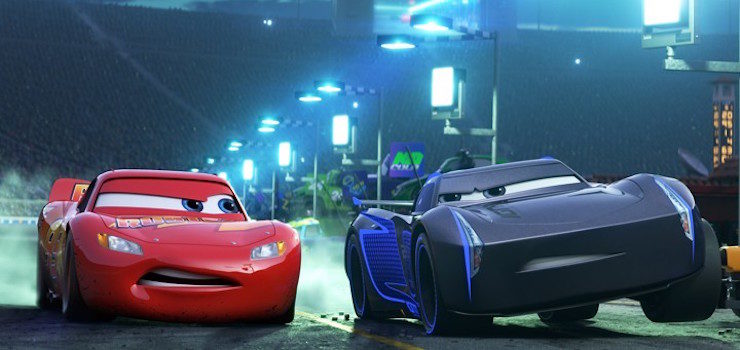“Lesson one. You’re old. Accept that.”
I don’t like the Cars franchise.
Especially the film part of it.
There, I said it.
What started out as a vaguely creepy and not really all that well thought out if genuinely good looking film about anthropomorphic cars turned into a yeah still creepy and not all that well thought out if genuinely beautiful film about spy cars in its second installment and, in its third installment, into a seriously creepy and definitely not all that well thought out if spectacularly beautiful film about anthropomorphic cars turning old and getting slammed with clinical depression and look, gorgeous, color drenched images of U.S. landscapes can only do so much.
And that so much is just not enough.
Is Cars 3 a technically better film than the first two Cars flicks, not to mention one that honestly tries to engage with a couple of the major issues from those films? Sure! Does Cars 3 offer an astonishing range of different racetracks from dirt to high tech, apparently inspired by various NASCAR tracks around the country and a few tracks no longer in use? Also sure!
I still hated this film.
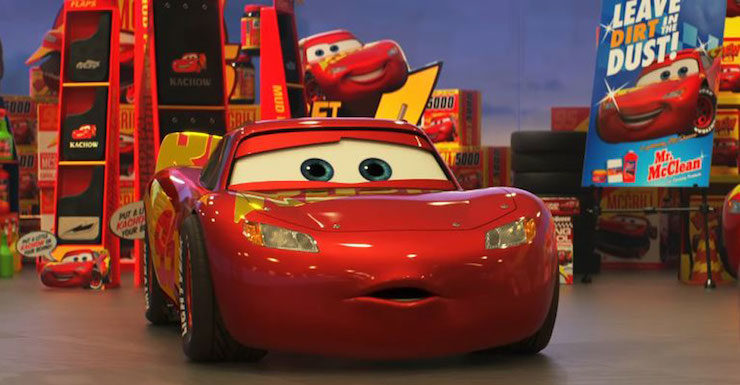
Back in 2011, Pixar and Disney were not overly concerned with my feelings about anthropomorphic cars. Cars 2 had just been released to the grudging praise of “Well, it could have been worse,” a box office take somewhat higher than the one from the original film, and—most importantly, from Disney’s viewpoint—outstanding merchandise sales. Indeed, from 2006—2011, the Cars franchise had grossed about $10 billion from merchandise sales alone, making it one of Disney’s most lucrative franchises—if one still trailing behind Winnie the Pooh and Disney Princesses. Plus, Toy Story 3 had done quite well at the box office and with selling Buzz Lightyear toys. A third Cars film was definitely in order.
And although no one exactly had a plot or idea in mind, they did have one major advantage: RIS, a new rendering system tested out on Finding Dory, which allowed animators to animate and shade and darken scenes all at once—giving a near immediate sense of the final product. For audiences, RenderMan RIS had a different advantage: richer, deeper colors for background images, and carefully shaded individual blades of grass that shifted in color from scene to scene and time to time. It also helped give the speeding cars a blurred look, imitating that video effect, and adding realism to a film with a basis less and less realistic every time I think about it.
RenderMan RIS didn’t quite eliminate all of the technical challenges. For a film ostensibly about the arrival of news higher tech cars, Cars 3 has a lot of mud, and I do mean a lot of it, mostly in a demolition derby scene but also in other, quieter moments. As it turns out, animating moving mud and making it look nearly photorealistic is not quite as easy to do as it is to type. The problem, at least according to animators, is that mud is something between liquid and solid, creating lighting issues, movement issues, and other assorted issues. For this, Pixar needed a different program—Houdini.
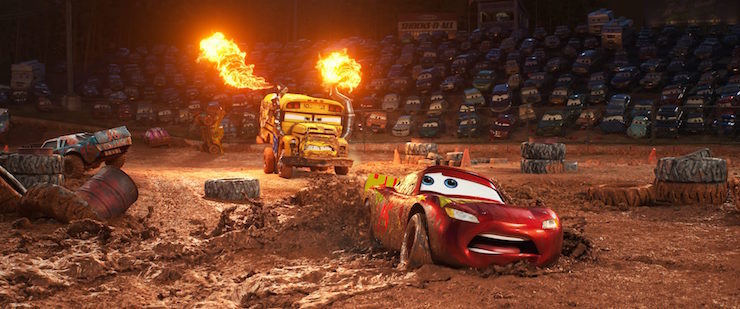
All of this, and Disney’s insistence that Pixar release both 2D and 3D editions of the film, meant that the animation and rendering process took more time than it had for Cars, instead of less—even with what Pixar termed “farms” of computers working on the film. Somewhat fortunately, they found themselves slightly helped out by the development problems with The Good Dinosaur, which pushed Finding Dory back a few months, allowing Cars 3 to be released in 2017, and giving the animators slightly more time.
The development issues with The Good Dinosaur also sent Bob Peterson back to work on the Cars 3 screenplay, along with Kiel Murray and Mike Rich. The film was directed by Brian Fee, who previously had worked as a storyboard artist and animator on a number of Pixar films. Most of the original voice actors from Cars were brought back to reprise their roles, with a few exceptions: Bob Peterson took over for Michael Keaton, busy with other commitments, and Lloyd Sherr took over for the minor role of Fillmore, previously voiced by George Carlin, who had died in 2008. Rather than to have anyone attempt to reproduce Paul Newman’s unmistakable tones, Pixar used archival recordings of unused dialogue from the first Cars film, thanking the actor’s estate in the credits and giving Newman a posthumous acting credit. Cars 3 also brought in comedian Cristela Alonzo to voice new character, racing car trainer Cruz, Chris Cooper as new mentor character Smokey, and renowned character actress Margo Martindale as Louise “Barnstormer” Nash, who has fond memories of car racing in the old days, as well as various celebrities voicing minor cameo roles.
Two of these characters also helped to address a concern noted by both critics and Disney executives: the problem that throughout two straight films, the race cars had all been voiced by men. Cars had featured a few cars voiced by women, as well as an attorney car who doubled as Lightning’s love interest, and Cars 2 had a spy car voiced by a woman, but the race cars? Men. This was partly because when Cars was made, many famous race car drivers—not incidentally the ones that Pixar pulled in for cameo voice roles—happened to be men, and partly mitigated by the presence of spy car Holley Shiftwell in the second film. And also partly because Pixar films up until Brave (created after Disney’s purchase of Pixar had tended to focus on male protagonists, to the point where even now, only three of the nineteen Pixar films—Brave, Inside Out, and Finding Dory – center on girls. A third Cars movie could, Disney felt, somewhat address that problem by bringing in a girl car. Or maybe three, if they added in a long retired car and maybe—just maybe—a demolition derby truck car, both voiced by women.
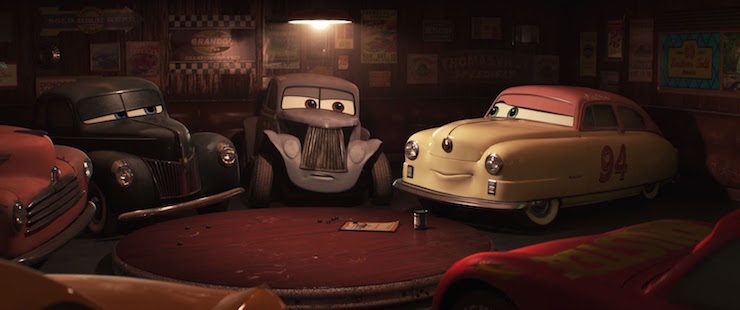
The demolition derby truck turned out to have too small of a role in the film to make much of an impact one way or another—though the truck was able to show off Pixar’s new mastery of animated mud. But Louise “Barnstormer” Nash (loosely inspired by real life NASCAR driver Louise Smith), somewhat clumsily tackled the all men race car issue by explaining that when she first showed up to race, the other cars didn’t like the idea of a “lady racer” so they wouldn’t let her have a number. So she stole one. Heh.
And racing car trainer Cruz—well. Her role is a bit more questionable, as we’ll see.
Cars 3 starts off by briefly reminding us of the various characters—racing car Lightning McQueen; his now apparently dead mentor Doc Hudson (among the many problems here: Cars is extremely vague about how, exactly, sentient cars can “die” given that (a) they can be and are repaired throughout this film and (b) a Model-T, presumably created sometime before 1927, is still rolling around); Mater, still as annoying as ever; Sally Carrera, serving mostly as a barely seen cheerleader and occasional attorney (mostly making me wonder: do sentient cars get married and have little cars? See, Cars 3, this is the sort of thing you’ve avoided explaining for three films now and it’s really starting to bug me); and the rest of the Radiator Springs crowd, with only Luigi and Guido playing any sort of ongoing role.
All seems well at first, as Lightning jokes with his fellow race cars—until, gasp, Lightning loses a race, to a younger car with more advanced tech. The racing season gets worse and worse, until Lightning tries to win with one desperate move –
— and crashes.
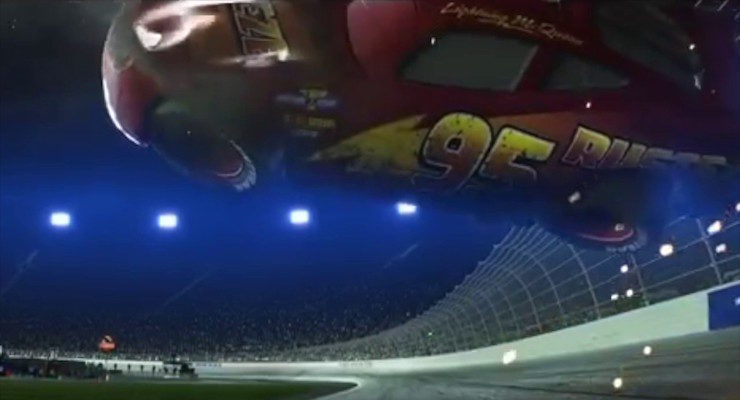
The crash scene appeared in several Cars 3 trailers and reduced at least some small kids, more fond of Lightning than I am, to tears. In the film, it’s pretty much immediately followed by a scene showing that Lightning is alive and well physically, if very depressed mentally, somewhat limiting its impact—as do later scenes suggesting that Lightning is more traumatized by losing than by the presumably painful memories of the car crash. (I know, sentient cars, but several of the cars complain about various aches and pains, and in Cars 2, a spy car was tortured, so, yes, they can feel pain.) Lightning mopes for some time before Sally Carrera comes in to offer some motivational words before vanishing for most of the rest of the film. It says something about their relationship, and not a great something, that Lightning later gets updates on how she’s doing from Mater, but let’s move on. Lightning decides to start training to race again, determined to beat new rival Jackson Storm.
To do so, he needs to train, so he heads up to Rust-eze’s new state of the art training center—now under the new ownership of big racing fan Nathan Fillion. (Pixar would doubtless like to interrupt me here to point out that Nathan Fillion has a name in the film, but the name doesn’t matter: it’s Nathan Fillion.) Here he starts training under the enthusiastic guidance of trainer Cruz—one of those girl cars that Disney hoped would sell more toys.
And here’s where things really start to go wrong with the film. Oh, not with the toys. Disney was spot on about that. The Lightning McQueen/Cruz Ramirez twin sets were instant toy hits, and Cruz independently sold plenty of little yellow cars. And not with the art—Lightning’s trip up to the Pacific Northwest looks stunning, a model of just what can be achieved in computer art. No, the rest of the film.
Up until this point, Cars 3 had just been, well, depressing, a film mostly about getting old and shoved out of the way in favor of younger, more energetic and tech friendly models—a rather encouraging note for younger viewers, now that I think about it, if perhaps a little less comfortable for their elders, especially their grandparents. As the training starts, however, Cars 3 moves from being just depressing, to being mildly freaky and inconsistent.
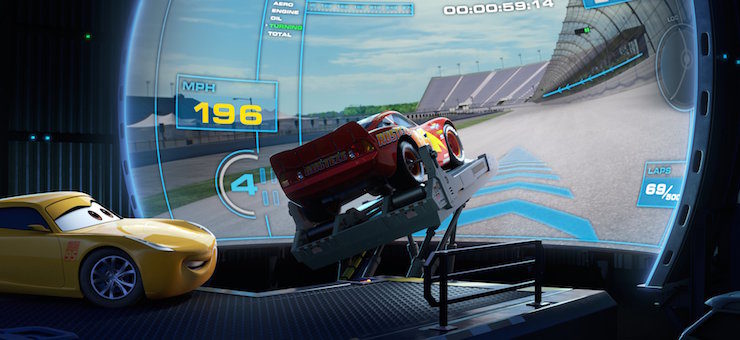
This is partly thanks to the images of cars running on treadmills and having their trainers blow bugs into their faces er windshield which, mildly creepy, and also, didn’t the first Cars movie sorta imply that all of the bugs had been changed into Volkswagen Bugs, in which case, even more creepy. And it moves on to Nathan Fillion starting off Lightning’s training by cheerfully saying “But first, let’s get you into a more contemporary look,” and by “more contemporary look,” what Fillion MEANS is that Lightning is going to be heated up and have his sides squeezed in and we do know how hot things need to be in order to GENTLY shape car metal and not just, well, dent it, and this is all happening to a SENTIENT CAR and have I mentioned just how disturbing the Cars films can be if you try to think about them?
This is all to put an electronic suit on Lightning so he can be precisely tracked right down to his vital signs WHICH IS NOT REALLY ANY LESS CREEPY if you think about it and maybe I should stop trying, but I’m only part of the way through this film. Let’s keep going.
Then there’s the trainer, Cruz, who says things like, “You can use anything negative as fuel to push through to the positive,” which, yuck, but again, we’re only part way through the film, so, let’s move on. She’s supposedly gifted at training and motivating race cars, and yet, she starts out by making a number of incredibly tactless comments to Lightning about his age. It’s awful to watch. And inexplicable—not just because she’s a motivational trainer but because, as Cars 3 later reveals, when Cruz was a little car (let’s try not to think about this) she watched all of Lightning’s races and dreamed of becoming a race car just like him. Frankly, her earlier comments make that later revelation ring a little hollow.
She later says that she looks different than the other racers and lacks their confidence, thus why she left her first race she dared enter—but this story, too, doesn’t match with her earlier scenes of brash self-confidence and conviction that she’s correct. And as far as appearances go—multiple scenes show us ever evolving racing car shapes, and also, cars actually changing their shapes and colors and adding details that allow them to turn into race cars. It’s meant to make us sympathize with her—and also reinforce Disney’s ongoing “never judge by appearances” message—but it falls flat. I mean, sure, it’s possible that she’s put on that veneer of brash self-confidence to hide her inner anxieties, but if so, that’s not something that really comes across in the film.
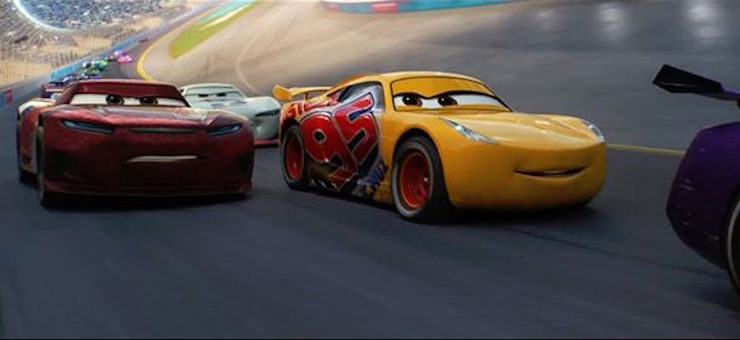
And that “never judge by appearances” message is further undercut by the ending, where yes, the race car that never thought she could even enter another race, much less win one, finally wins—but most of that race was run by another car, Lightning, making this a shared win. Could she have won the race had she started with the other cars at the beginning? Maybe—maybe not. It’s not just a long, endurance race; it’s an intelligence race, with pretty much every race car agreeing that Lightning might not be the fastest—but he can be the smartest. Could Cruz have matched that intelligence? It’s not clear.
Buy the Book
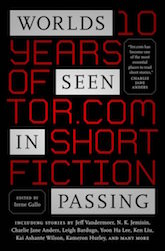

Worlds Seen in Passing: Ten Years of Tor.com Short Fiction
There are other odd bits—for instance, the way the major car race in Florida is not at NASCAR hot spots Daytona or Homestead, but Miami Beach, and, while we’re at it, the way the beaches in Miami—Miami—seem completely deserted. I mean, yes, I get that these are sentient tourist cars, not sentient tourist humans looking for some sun, but it still feels totally wrong. And also, what happened to the bridges, and how exactly do condos work with sentient cars, and…and…I need to stop asking these questions, don’t I? Or the moment when Nathan Fillion comes and rather than giving Cruz the dressing down she absolutely deserves for disappearing from his high tech training center, not warning him that the car he intends to use as a major marketing brand is about to make a major PR mistake, and then vanishing for days, instead orders her to leave in the middle of a race to go start training another car. At this point, Lightning is actually doing pretty well in the race—not winning, but with a solid chance of placing in the top ten, and there’s no reason why Cruz can’t wait around for another few hours to watch the end. But no—Nathan Fillion orders her to return to the other side of the country, and then adds a few gratuitous insults about her appearance, pointing out that she’s not a racer, she’s a trainer.
It’s all to set up the final twist, but it’s a setup that doesn’t make any sense—not to mention that up until this point, the film has made a big point of noting that the most successful trainers were all former race cars, thus, Cruz actually racing a race or two would turn her into a better trainer, something Nathan Fillion needs.
So, Cruz, a character brought into the film in part to increase the franchise’s girl power, ends up spending most of the film doubting her own racing abilities, and wins only by finishing someone else’s race. I guess this is mildly better than the general lack of girl power in Cars and Cars 2, but not by that much.
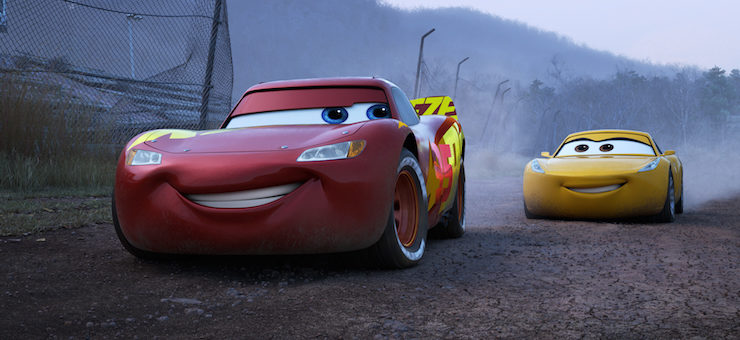
I’m also not at all clear on why, exactly, Lightning feels so old and beyond racing. Oh, sure, new high tech cars, but Cars came out in 2006—not all that long ago, and certainly not all that long before this film’s 2017 release. Admittedly, car racing, not my thing, so I had to look this up, but as it turns out, yes, many NASCAR drivers have enjoyed careers lasting more than ten years—including some drivers voicing roles in this film. I realize that real life cars frequently start breaking down after ten years (if not sooner) but surely anthropomorphic cars can and do last quite a bit longer—especially given all of the many sentient mechanic cars driving around, not to mention that at some point, the sentient cars have developed precision engineering. Something that race car Lightning presumably should have had back in 2006 (and seemed to). Also, is this precision engineering only available for shiny new cars and race cars? That seems mean.
It’s not that the film doesn’t have its lovely touches. As said, it looks fabulous—the background work here ranks as some of the loveliest stuff that Pixar has ever created, which is saying something. It includes several nice nods to the first film, from the cameo appearances of earlier characters to Lightning’s protégé finally earning the Dinoco sponsorship that a younger McQueen had once longed for. And if I continue to question just about everything about the lives of sentient cars as portrayed in this franchise—well. I can’t help but like the message here about how life doesn’t have to end just because one part of it changes.
Cars 3 earned $384 million at the box office—enough to cover its reported budget of about $175 million plus marketing costs, if considerably less than the $462.2 million earned by Cars and $562.1 million earned by Cars 2. Still, as with the earlier Cars films, the chief money was in the merchandising, with Cars toys, clothing, furniture and other assorted items still highly popular with kids—even if Lightning McQueen had gotten old. Critics, too, were kinder to Cars 3 than they had been to Cars 2.
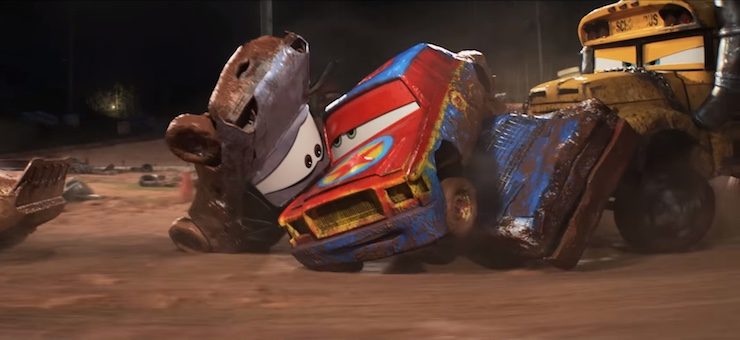
It was enough, in any case, to allow Owen Wilson to announce that yes, Pixar was tossing around ideas for a, sigh, Cars 4.
I can only hope that Mr. Wilson is wrong about this.
Meanwhile, Pixar had something a bit more ambitious for their next film.
Coco, coming up next month.
Mari Ness lives in central Florida.










